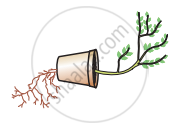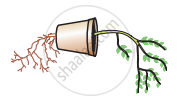Advertisements
Advertisements
प्रश्न
Name the following:
The tropic movement of plant parts in response to chemicals.
उत्तर
Chemotropism
Explanation:
Chemotropism is the movement of plants brought on by chemical stimulation. Negative chemotropism results from a growth response away from the stimulus; positive chemotropism results from a growth response directed towards the stimulus. One such is the development of pollen tubes towards ovules.
APPEARS IN
संबंधित प्रश्न
What does a plant root do in response to water? What is this phenomenon known as?
What happens to the moonflower
- during the daytime, and
- at night?
What is this phenomenon known as?
Distinguish between tropic movements and nastic movements in plants. Give examples to illustrate your answer.
Which of the following is a growth movement and which is not?
- Folding up of leaves of sensitive plant on touching with hand.
- Folding up of petals of dandelion flower when light fades.
What are the different types of tropisms? Define each type of tropism. Write the name of stimulus in each case
What is the difference between thigmotropism and thigmonasty? Name one plant which exhibits thigmotropism and one plant which exhibits thigmonasty. What behaviour (or responses) of these plants make you think that they exhibit thigmotropism and thigmonasty respectively?
The movement of sunflower in accordance with the path of the sun is due to :
(a) photonasty
(b) phototropism
(c) hydrotropism
(d) chemotropism
The bending of the shoot of a plant in response to light is called :
(a) geotropism
(b) phototropism
(c) thigmotropism
(d) photonasty
In the given figure (a), (b) and (c), which appears more accurate and why?
 |
 |
 |
| (a) | (b) | (c) |
Analogy:
Towards a stimulus: ______:: Away from the stimulus: Negative tropism.
